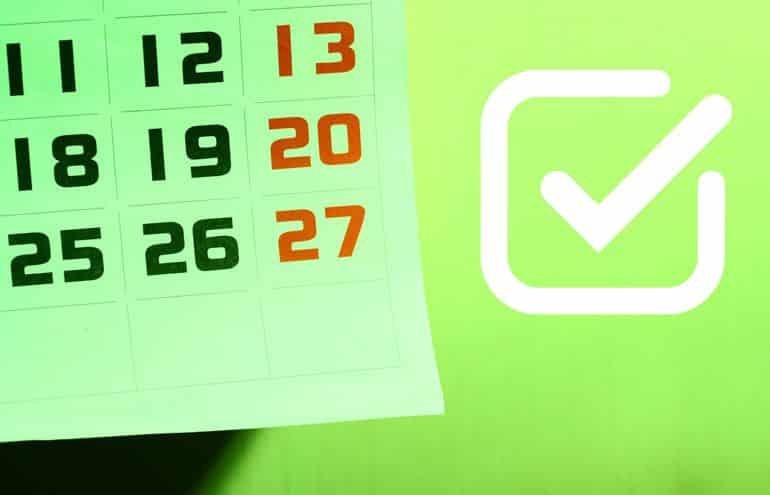Attorney business development isn’t easy — especially when you don’t have time to lay the groundwork. This checklist will help you make headway in just a few focused hours.
Your business development department or practice leader has been pushing you to work on business development activities. Meanwhile, your clients have you billing more hours than ever. The balance between billable and nonbillable work has always been difficult.
But finally, at long last, you have a free weekend with no obligations except cheering on your favorite football team (if you’re into that kind of thing). A time to exercise or relax, mow the lawn or clean the house and — you guessed it — spend a few hours performing 10 marketing and business development activities that will help your business, your relationships and your practice in the long run.
Table of contents
- 1. Read This Article (14 Minutes)
- 2. Update Your LinkedIn Profile (30 Minutes)
- 4. Check the Upcoming 12 Months for Relevant Conferences (15 Minutes)
- 5. Write the First Draft of a 300-Word Blog Post, Article or Alert (60 Minutes)
- 6. Clean Up 20 Contact Records That You Share to Your Firm CRM (15 Minutes)
- 7. Expand Your Professional Network With Seven New LinkedIn Connections (10 Minutes)
- 8. Review Your Firm Bio (30 Minutes)
- 9. Enjoy a Physical Activity With a Client or Colleague to Build Relationships (2 Hours)
- 10. Ask Your Business Development and Marketing Department What Opportunities They Suggest (1 Minute)
Here’s your checklist — 10 business development activities you can complete in one weekend.
1. Read This Article (14 Minutes)
We aren’t reinventing the marketing and business development wheel here. Just a friendly reminder of the tasks your marketing and business development teams keep pestering you about.
2. Update Your LinkedIn Profile (30 Minutes)
Perhaps the easiest and most often overlooked marketing activity for an attorney (or any professional for that matter) is to keep your LinkedIn profile up to date. Relying solely on your firm bio as your online presence is not enough these days. Statistics come out every year that specifically indicate what an important role LinkedIn profile reviews play in the initial vetting and research done by general counsel, C-suite executives and other business decision-makers when hiring outside counsel.
I’m not going to cite them, but … Don’t believe me? Google yourself. Did your LinkedIn profile show up on the first page of the search results? Perhaps even in the No. 1 or 2 slot? That should be enough for you to do the following to spruce up your LinkedIn profile this weekend.
Add or update your headshot and cover photo.
Your headshot should be current. If it doesn’t look like you today, then it is time to upload a new headshot. And a cover photo gives you a chance to share some context. Are you an avid runner, a fisherman, an outdoors person, an artist, or simply a lover of your city? Try adding a nice, contextual photo that you’ve taken in the cover photo slot. It could be from a recent trip or of your city skyline. Or if you’d like to keep it professional, choose a professional setting photo or ask your marketing department for a pre-sized image to upload.
Create a descriptive headline.
Do not leave the default “Partner at Generic, Sample, and Typical LLP.” Provide a description of what kind of attorney you are and the area of law you practice. The keywords in the headline also affect how search engines or LinkedIn searches pull your profile into the results. Try instead:
- Transactional Lawyer Helping Small Businesses With Merger & Acquisition Matters
- Labor & Employment Attorney Focusing on Workplace Safety, Employee Policies, and Operational Advice
- Litigator | Banking & Financial Services | FinTech | Data Breach | Data Privacy
Write a 250-word summary (About section).
Work on a summary. Make it direct and to the point. Tell potential clients what you do, how you will help them, why you are good at what you do, and how you got to where you are today. Add some personal or other professional and community activities as background. Done.
Tips: Write this in first-person; it is your personal profile. You also have up to 3,000 characters in this section.
Add all relevant work experience and education history.
Your previous work and education evidence how you became the attorney you are today. If it isn’t relevant work, feel free to omit, but anything that shaped your skill set is important here. You may also find that you connect with people based on your alma maters and work alumni status.
Add licenses, certifications and previous publications.
Use the “Add profile section” button at the top of your profile page. These additions will provide more proof of your credibility and skill set.
(Additional tips for attorneys writing social media bios can be found in this Good2BSocial blog post and in Nancy Slome’s post here.)
3. Email Three to Five Contacts (20 Minutes)
There is a principle in marketing and advertising called the “Seven Touches of Marketing.” The concept says that it takes at least seven different interactions with your brand, product or call to action before a decision-maker is open to making a purchase or acting on your call to action.
The same concept can be applied to business development and attorney-prospect relationships. Nurture the relationship with several different touchpoints over time. Earn trust and credibility, and don’t be deemed a “salesperson” by being organic and thoughtful. Looking for an easy way to hit one of those seven touchpoints? Check in with an email.
- Send a client a relevant or interesting article.
- Check in with an old law school classmate.
- Follow up with a conference attendee you met.
- Ask how a recent prospect’s vacation went.
4. Check the Upcoming 12 Months for Relevant Conferences (15 Minutes)
You don’t need to book the conference. Instead, make yourself a simple “business development conferences calendar” and review your budget next week to see which one(s) works for you. Here are some networking tips for when the day comes.
5. Write the First Draft of a 300-Word Blog Post, Article or Alert (60 Minutes)
Being a thought leader is one of the best attorney branding tactics out there. Be the smartest of the smart people and stand out. That starts with authored content.
There are a few ways to dive into this business development activity, but as an attorney, the simple guiding principle is “Be useful!” Take an issue that is important to your client and provide clear commentary about why or how the issue could affect their business or industry. And the kicker, provide actionable takeaways that the audience can work on now.
Here are some ideas to jump-start your creative process.
Take a common issue and write about it.
What do your clients worry about regularly? What is the most common question you are asked? What keeps you up at night? This is a simple set of questions to find your first “evergreen” topic.
An evergreen topic is something that will remain valuable to your audience at any point in time. Sure, it may need to be updated from time to time, but the topic will always be a relevant issue that your potential clients will face. Be the source with the answers to these questions and wait for the phone calls to come in.
Take a recent question from a contact or client and summarize how to solve it.
If you solved one client’s problem, the likelihood is another prospect has that same problem that needs solving. Make the post easy and accessible. Describe the question at hand, state why it is an issue and how it impacts a business, and provide the actionable next steps to prevent it from happening or to fix the problem once it has occurred. It shouldn’t be legal advice, but enough to get a business owner to pick up the phone and ask you, “How do I complete these action items?”
Repurpose a slide deck, conference presentation or webinar into a blog post.
Your last slide deck is literally an outline for a blog post. You can take everything you already have — including slide titles — to combine them into short paragraphs and bullet points with headings and subheadings. You will have a draft ready in no time.
When you already know about a topic, this process can take as little as 20 minutes. Revisit the post later to flesh out the finer details. This doesn’t have to be painful or time-consuming. Just get the thoughts on the page to start. (Take, for example, that No. 5 on this list is essentially the entirety of a 400-word blog post.)
6. Clean Up 20 Contact Records That You Share to Your Firm CRM (15 Minutes)
Have you made sure your Outlook contacts are still accurate? Save yourself the trouble of bounced emails or the pesky marketing team bugging you to review your contacts by cleaning up your contacts one small chunk at a time.
If you can’t recall what company your old client moved to, research the contact on LinkedIn. Which brings us to your next simple business development task for the weekend.
7. Expand Your Professional Network With Seven New LinkedIn Connections (10 Minutes)
You can use the connection suggestions that LinkedIn provides but only connect with the ones that are meaningful to you and your business. Or better, use the “4 C’s of LinkedIn Connections” as a guideline: Colleagues, Clients, Conferences and Classmates.
- Colleagues. Anyone who you work with, who is in your particular office, or who is in your particular practice group should be a part of your connection network.
- Clients. This should be a given. Find clients or potential clients you have been meeting with and connect with them. Now that your profile is in tip-top shape (see point 2 above), you should be proud to show off your “resume” to them.
- Conferences. The first tip here is to already be connecting with acquaintances at a conference the moment you leave a conversation. But that can be tough if you are bouncing between conversations. Take a minute to find those recent conference encounters on LinkedIn and connect with them. Include a personal note that references the conversation or the conference name where you met to jog their memory of the interaction.
- Classmates. College counts. Law school counts. Post-grad counts. Heck, even high school counts. You never know where these folks have landed in life or where they will be heading. Many of them will have made it to general counsel, C-suite executives, business owners or decision-makers. And who is to say that your accountant, banker or insurance broker friends wouldn’t benefit from a two-way referral source street?
This business development network-building activity is important for future follow-ups (recall the Seven Touches of Marketing), staying “in the know” about your professional network, and researching contacts in the future.
8. Review Your Firm Bio (30 Minutes)
This one should be easy if you have already reviewed your LinkedIn profile per No. 2. Pull a Word document of your bio (your business development team or website content manager should be able to get you a clean Word copy) and start making your edits in track changes. Once you are ready, send the track-changed document to your marketing and business development team for additional review, and have your website content manager implement the changes to the website.
9. Enjoy a Physical Activity With a Client or Colleague to Build Relationships (2 Hours)
You were likely going to do an activity, regardless. Build a friendship so your working relationship is stronger, too. And keep the work talk to a minimum! This is your chance to know the person in addition to the business.
- Haven’t joined the pickleball craze? Give it a shot. It is low-impact and fun.
- Golfer? Invite a client for a round of golf.
- Outdoorsy? Take a hike at a local trail system or recreation area.
- Runner or walker? Knock out a few miles, but be sure to start and end at a local brewery for post-run beers.
- Kid-friendly? Invite their kids over to play in the yard or at the park while you catch up.
- None of these for you? Just pick up the phone and call a colleague or client. A coffee, lunch or happy hour beer may be in your future.
10. Ask Your Business Development and Marketing Department What Opportunities They Suggest (1 Minute)
If you’re on this last paragraph, you’ve at least made it through No. 1 on the list. Nice!
Decided this is too much for you? Try only three or four of these business development activities to get started. Something is better than nothing and your business development team will give you a pat on the back come Monday.
But it should be said, this list only tallies 5.25 nonbillable hours over your two days of a weekend ….






















